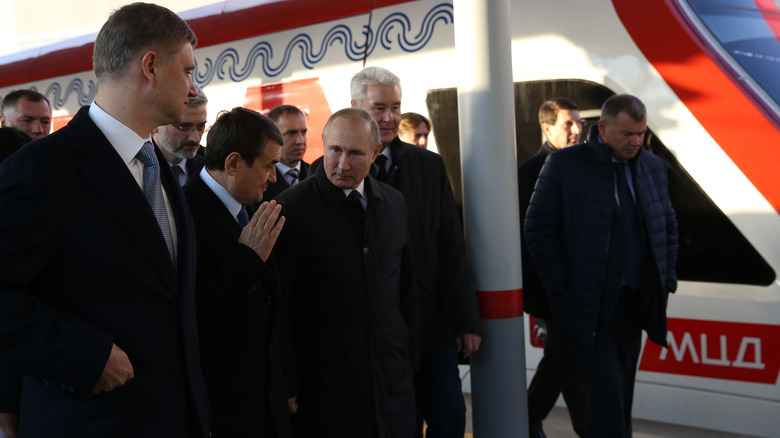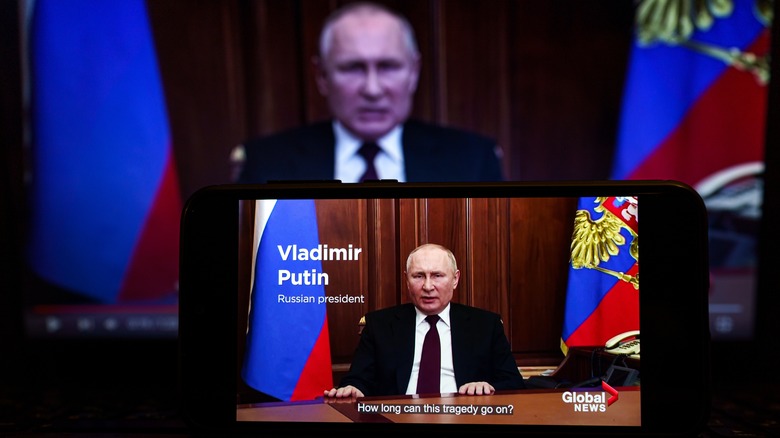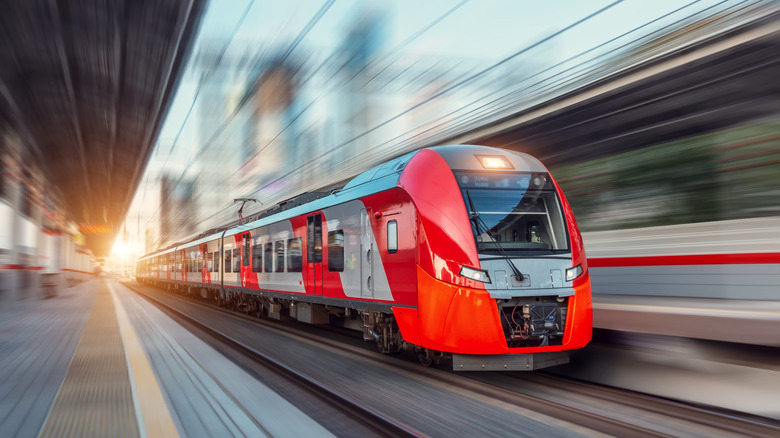The Untold Truth Of Putin's Ghost Train
It was Benjamin Franklin who was credited with saying, "Three can keep a secret, if two of them are dead." That's a pretty accurate observation when it comes to human nature and the somehow innate urge to immediately share something that's been told in confidence, and that makes it even more shocking that something as big as an entire train has remained cloaked in mystery.
That train belongs to the Russian president Vladimir Putin (mostly, maybe — more on that in a minute). And that kind of goes a long way in explaining just how so much about the train has remained shrouded in mystery, with little known about it aside from the fact that when it appears on railways across Russia, no one ever expects it and no one ever knows where it's going.
That's not to say that information hasn't gotten out, including some pictures that were made public by the Kremlin itself. Those mostly feature images of meetings held in a boardroom, and while sure, it's the kind of boardroom that's elegant, elaborate, and decorated in a perfectly predictable, upscale sort of way, it's not really surprising, is it? Putin has been using his train for years, and it was only in 2023 that a combination of leaked documents and a high-ranking defector pulled back the curtain on what else is in the 22 cars of the train. And some of it? It's not entirely as ordinary or as expected.
A need for secrecy increased Putin's reliance on trains but leaks still happened
Most of the information that's come to light about Vladimir Putin's so-called ghost train comes from just a few sources. First, there's Gleb Karakulov. Karakulov had risen through the ranks of Putin's Federal Guard Service and was one of the engineers responsible for overseeing Putin's ultra-secure communications systems. He defected in 2022, and according to The Dossier Center, he's the highest-ranking intelligence officer to do so. It was Karakulov who revealed (via CNN) that the train began to be overhauled to Putin's standards in 2014, but only really came to be used on a regular basis in late 2021. Why? Security.
Putin, Karakulov said, was concerned about having his movements tracked: "The plane, as soon as it takes off, it immediately crosses flight radar. The train, it is used in order to somehow hide these movements." It's also worth mentioning that this was around the same time he was planning the invasion of Ukraine.
Karakulov hasn't been the Western world's only source of information on Putin's train. The Dossier Center was also given around 25,500 documents leaked from the Zircon Service, which — in the years since 1994 — has morphed from an aerospace-adjacent industry that built and designed railway cars for equipment testing to building those same cars, kitted out for the sort of luxurious comfort that's expected of Putin. When they scrubbed the documents, they found some fascinating information on just what is inside the 22 cars of Putin's top-secret train.
Putin requested a whole car dedicated to health and well-being
On Friday, August 5, 2022, Vladimir Putin issued an order to "install gym equipment Hoist HD-3800 and Hoist HD-3200 ... in the sports-health wagon No 021-78630." It wasn't until the massive document leak hit that the order was associated with Putin's train, and it turns out that gym equipment is just a small part of what's in the train car.
The Dossier Center found documents that sort of passive-aggressively talked about the overhaul as well as the construction of the car, saying that Putin had previously demanded quite a bit be done "under the most difficult conditions... in an unrealistically short time." While it's not clear just what equipment was added on the August 5 order, photos of the interior of the train show a slew of fitness equipment that includes dumbbells, a bench press, a hyperextension machine, and interestingly, they also note that a common theme in the machinery is a focus on building thigh muscles.
The car also contains a hammam — a Turkish steam bath, like the one pictured — and a cosmetology center/beautician's office, outfitted with everything that's needed for a high-end spa. Itemized lists detail a slew of masks — green tea, cherry blossom, seaweed, and biocellulose — along with tonics, emulsions, extracts, gels, and sponges. It's also worth noting that in a statement to CNN, the Kremlin said, "President Putin does not have such a car in his use or in his ownership."
The train is equipped with serious medical gear
The health and wellness car on Vladimir Putin's train isn't just about looking good, it also seems to have a section that's outfitted as well as any emergency vehicle on the road. Documents examined by The Dossier Center show that some seriously life-saving medical equipment has been installed, including a defibrillator, an artificial lung, and patient monitoring equipment. Of what sort? The kind of computer systems that can monitor a person's vitals while they're under anesthesia, or on ventilation suggesting that if the need was to arise, the team on board the train could even perform surgery. (This is also a hint that there's a medical team on board.)
Not only does the car contain everything that's needed in the case of a medical emergency or injury, and given how famously health-obsessed Putin has been (and in the face of oft-repeated questions and rumors about his health), it's also telling that it was specifically requested that the car also be equipped with anti-listening device technology. The car is described as having equipment that "protect[s] against the leakage of acoustic information."
The television presented a unique problem
When The Dossier Center interviewed ex-Federal Guard Service captain Gleb Karakulov, he shared some insights into the regime — and everyday life — of Vladimir Putin. During the interview, he confirmed that Putin didn't use a cell phone or the internet, and instead relied on secret service reports and Russian television for his news. Karakulov said that one of his requirements was to have access to Russian television wherever he was, and that included his train. But that was apparently easier said than done.
Several televisions were installed in the car, but long before it was ever put to practical use it was very quickly discovered that pretty much anything — from going under overpasses to passing through the shadows of buildings — would disrupt the signal. The initial solution was pretty straightforward, which was to simply start the journey by loading broadcasts into a buffering system that would allow for constant, uninterrupted broadcasting even during the moments when the signal was interrupted. That, however, wasn't good enough: Putin had apparently made it clear that he didn't want to wait for the programs to load every time he changed channels.
The ultimate solution was to develop new and unspecified buffering technology that would avoid the wait times. According to the documents, that technology was expected to be installed in other aircraft, which was presumed to mean Putin's other transports.
There's a total of 22 cars that can be swapped in and out
Vladimir Putin's fully outfitted cosmetology center isn't even the most interesting part of the information uncovered by The Dossier Center. (Although it is, perhaps, the most meme-worthy.) There are actually 22 cars that have been outfitted to Putin's specifications, and they can be swapped in and out as needed. It seems as though there's an average of 10 cars used for any particular journey, and not all of them were built for Putin.
Eight date back to the fall of the USSR. They're for the most part utilitarian, and according to their descriptions, they include three garage cars for transporting vehicles and a car-diesel power plant. There are also four "all-metal compartments," two of which are outfitted with communications equipment. That's in addition to two other cars that are designated as communications centers.
There are also three cars described with a word that translates to "salon," but that could mean a number of things — and it does: There's a handful of Russian words that are translated that way. This one — салон — suggests that it's an old-school gathering place way, as a cabin that's outfitted as a place to meet and greet guests, and also to serve up things like after-dinner drinks. There's also a luggage car, three restaurant/dining cars, and there's also two that translate to "luxury." Like the salon car, this specific word — люкс — has a more specific meaning: It's a luxury suite, reportedly complete with a bathroom, a television, and cassette players.
Security is, of course, incredibly tight
It almost goes without saying that Vladimir Putin's personal train comes with some serious security upgrades, that's true when talking about the transportation used by any world leader. Still, it's worth taking a closer look at them. The documents given to The Dossier Center include speeches from the head of the company that's responsible for upgrades and upkeep of the train, Zircon Service. In one, he gave a shout-out to the Federal Security Service, and further digging revealed that yes, Putin's security service had a lot to do with the building of the train and even the day-to-day maintenance.
The security measures revealed in the pile of documents likely don't tell the full story, but they're still interesting. In addition to some serious sound-proofing measures inside, the inside is packed with encrypted radio communication equipment, but it's possible that's not as cool as it sounds. Bizarrely, detractors say that it's far from top-of-the-line, and claim the methods used to protect communications are the same ones that have been used since the 1980s. They also go one step further, and say that some of the equipment is just as outdated.
Security features of the car Putin travels in are still classified, but other cars are said to have not only bulletproof exteriors that can withstand attacks from assault weapons and sniper rifles, but also places for return fire. It's also pretty fast: Exact speeds aren't clear, but it's suspected it can hit up to 125 mph.
The train itself is reportedly just one part of Putin's infrastructure
In early 2023, Proekt released (via Ukrainska Pravada) what they'd learned about Vladimir Putin's mysterious train, and shared the fact that the train was just one small part of it: He'd had a whole network of rails and stations built, too. They stated: "All of Vladimir Putin's main residences have been connected to railway lines, and secret stations have been built nearby."
A lot of the information they'd gained had come from those living nearby the stations, who reported they were heavily guarded and protected by high fences and barbed wire, yet used only by Putin's ghost train. The presence of stations near some of his homes has been confirmed with the help of satellite imaging, and seemed to have been built in the same time frame that the train was.
Further investigation by a media organization called Sobesednik found (via Ukrainska Pravada) that it also seems to connect not only the residences but a series of secret bunkers built underneath them. They connected the dots through the builders: The company that built a network of tunnels, passages, and bunkers beneath Putin's Krasnodar Krai palace built them beneath other residences, too. The tunnels — reportedly going as deep as 650 feet underground — are a heavily guarded secret, with stories told of those who find them suddenly finding themselves in prison. The train itself, meanwhile, is apparently kept at a railway station called Moscow-Kalanchyovskaya.
Putin reportedly has strict quarantine procedures in place for those on the train
When The Dossier Center interviewed defecting intelligence officer Gleb Karakulov in 2023, they touched on a whole bunch of different topics, including the rumor that Vladimir Putin had retreated to an apparently permanent, COVID-style lockdown. Karakulov confirmed the rumor and added that anyone who wanted to be in the same room with him — even for a few minutes — had to first agree to a two-week quarantine. Other employees simply stay in quarantine with Putin.
"Everyone is a little perplexed as to why this is still going on," Karakulov said. "Because everyone has been forced to get vaccinated. Everyone undergoes health screenings, monitors their health, and takes regular tests. ... I have no idea why; he's probably just worried about his health."
Karakulov also confirmed that the quarantine period extended to everyone on the train as well. He estimated that it had started being used on a regular basis by September of 2021, and said that yes, the employees who remained on standby should Putin want to use the train had to remain in quarantine. "Since the beginning of the war, the guys said they would simply travel in the 'Valdai direction' for about 40 days to 45 days. There may not be a train departure on your particular watch, but people are always ready."
Trainspotting hobbyists threw a wrench in the works
Trainspotting — not the movie — is exactly what it sounds like it is, and it's a hugely popular hobby that started in the 1940s. Part of trainspotting is keeping meticulous records, particularly of train schedules, and that's what got Russian trainspotter Mikhail Korotkov into trouble.
In an interview with The Washington Post, he said he was one of the first people to get photos of Vladimir Putin's train and was one of the first to post them online. Along with the fact that it was never listed on any schedule, there were a few telltale signs that he was seeing the same train, including a distinctive white dome on the top of one of the cars. Korotkov documented where and when he saw the train on his blog, and said he didn't really think anything of it ... until transcripts of his private phone conversations started appearing in the comments on some of his YouTube videos. "I thought about my personal safety, and from that moment I realized that everything I had published on the internet could be used against me. I told my parents that my life was in danger."
Korotkov ultimately pulled down his blog, then left his friends, family, and job behind when he fled the country. "The hardest thing was to ... give up my past life and start from zero." He says that he feels his photos and information about Putin's train have left him with no choice but to remain on the move.
It's been built under the umbrella of a Russian oligarch
One of the most interesting revelations in the documents reviewed by The Dossier Center is that the train often referred to as Vladimir Putin's likely isn't actually his at all. Only the owners of four of the cars have been documented: two belong to Russian Railways, and two to a company called Vemina Aviaprestige. The owners of other cars remain classified, but there's also a really big hint that's right in plain view.
An unspecified number of the cars are decorated with branding from a company called Grand Service Express. That, in turn, makes it likely that Putin associate and oligarch Yuri Kovalchuk is the owner of at least some of the cars, and that's significant.
It's hard to overstate just what a big deal Kovalchuk is. In addition to being identified as "Mr. Putin's 'personal banker'" during the 2014 sanctions, he's also firmly positioned at the head of Russia's media. According to The Wall Street Journal, it's already well-known that he's supplied Putin with other modes of transportation — including yachts — and, he's supplied him with other things, too: Traitors — Kovalchuk owns the media company VK, which passes information shared by users right along to the Kremlin. He's also at the head of Russian Bank Rossiya, but finding out what else he's involved in is difficult: As with the train's owners, a heavy layer of shadow obscures many of the details.










